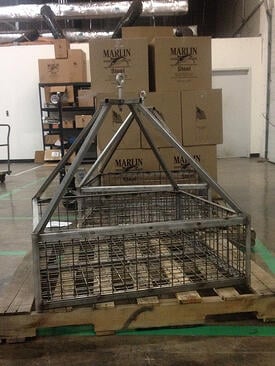 For many of the orders that Marlin Steel processes, customers are ordering a basket that is specifically designed to fit inside of some other object, such as the cavity of an ultrasonic parts washing machine or other specialized machine. When building baskets for a specific cleaning machine, there usually exists a stock basket that needs to be replaced. Many manufacturers rely on these stock baskets to have a model to copy so that they “know” that their basket will fit in the machine.
For many of the orders that Marlin Steel processes, customers are ordering a basket that is specifically designed to fit inside of some other object, such as the cavity of an ultrasonic parts washing machine or other specialized machine. When building baskets for a specific cleaning machine, there usually exists a stock basket that needs to be replaced. Many manufacturers rely on these stock baskets to have a model to copy so that they “know” that their basket will fit in the machine.
But, what happens when the basket isn’t for a specific machine with an existing basket design? What if you’re building a custom basket insert to go inside of a custom container?
Recently, a customer placed an order for several dozen custom steel baskets capable of holding single 2.42” x 5.55” cylinders. The fully loaded baskets would then need to be capable of fitting neatly inside of a 2.95” x 5.95” cylindrical cavity. Finally, the design of the basket needed to be compatible for use with remote manipulators and lifting hooks.
With only half an inch of tolerance for the thickness of the basket’s frame between the cylinder to be held and the walls of the cavity, there were several challenges in the design of this basket, including:
-
Keeping the basket thin enough to fit in the cavity while maintaining frame integrity (the basket had to hold 5 lbs. of weight).
-
Ensuring the baskets, when manufactured, could consistently stay within tolerance to allow a loaded basket to fit in the cavity.
-
Ensuring baskets were easy to manipulate with remote devices.
Fitting a Cylinder in a Basket with a Hoist in another Cylinder
 The first challenge was to find a way to make 0.53” of clearance between the object being held and the outer sleeve work. While half an inch is a lot of space, the diameter of the metal used for the basket’s wire frame would effectively be counted twice, once for each opposite end of the basket.
The first challenge was to find a way to make 0.53” of clearance between the object being held and the outer sleeve work. While half an inch is a lot of space, the diameter of the metal used for the basket’s wire frame would effectively be counted twice, once for each opposite end of the basket.
So, if a wire has a diameter of 0.25”, then it would cause the frame to take up 0.5” of the available space, leaving only 0.03” to allow for the basket to be inserted or removed with a remote handling device. With so little room to work with, using a remote handling device to remove/insert the basket would be incredibly difficult.
However, the wire had to be thick enough to retain the tensile strength needed to hold a 5 lb. object for long periods of time, so the wire could not be too thin either.
It was determined that using 0.121” thick wires for the frame would provide the tensile strength needed to prevent the frame from deforming under normal use, while leaving some “wriggle room” for remote handlers to remove or insert the basket.
Another design feature that had to be taken into account when planning how the basket would fit was the lifting handles which would attach the basket to the steel rope that allowed remote handling hooks to “grab” the basket to be lifted. When attached to the frame, a mount would add even more thickness to the basket, so the lifting “handles” had to be made from an exceptionally thin material as well.
Not putting a handle on the basket was out of the question, as this design feature was necessary to make the basket easy to manipulate with a remote device.
So, the lifting handles that would attach to the steel rope were made of 0.048” thick sheet metal plates and attached near the top of the basket’s frame. Combined with the outer frame, this made the basket 2.89” in diameter at its widest point. However, there was still the steel rope to consider. Any rope attached would add further to the diameter of the basket, and there was only 0.06” of space left.
To counter this, the sheet metal of the lifting handle was given a slight, 4° curve towards the inside of the basket. This would allow extra room for the attachment of the steel rope without obstructing the top of the basket.
Ensuring Consistency across Dozens of Baskets
For this design, there was a very strong need for precision in the manufacture of the basket. If the angle of a single bend was off by just one degree, the basket would not be suitable for the customer’s needs. The basket’s design was rigorously tested in a virtual environment to ensure that it would fit in the cavity dimensions specified by the customer while fully loaded without difficulty before moving to full production.
The next challenge was ensuring that the finished baskets would all meet the same tolerances. Cylindrical baskets, in particular, are notoriously tricky to do consistently by hand. This is why Marlin Steel’s manufacturing team doesn’t rely on manual labor for such tasks.
Using a series of metal bending robots, Marlin’s degreed engineers were able to ensure that every wire bend was performed at a consistent angle, from the first basket to the last. Unlike manual labor, manufacturing robots don’t get tired from repeating the same motions over and over, nor do they get bored at repetitive tasks. Because of this, automated manufacturing equipment can perform the same task over and over for hours on end with near microscopic consistency.
The end result was a perfect batch of baskets that fit perfectly in the custom cavity specified by the customer.
Learn more about how you can get the perfect custom wire basket for your needs today.



.gif)


